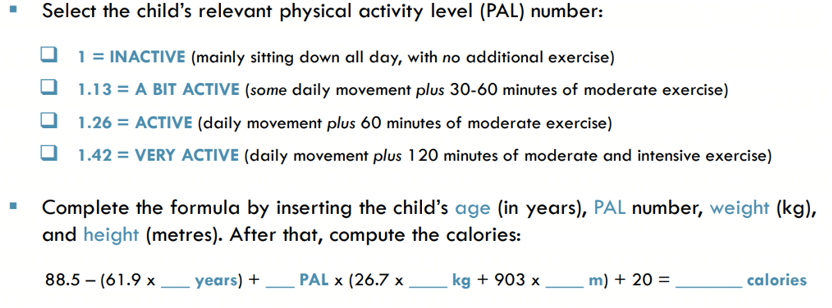Secrets of Carbohydrates Consumption in children’s nutrition: Impacts of foods high in “Free Sugars” and “Empty calories” on a child’s health
Table of Contents

Why do Children need to consume Carbohydrates in sufficient quantity and quality every day? Two ways of gaining weight
Calories provide fuel to the cells in the body. When we consume food and beverages, our body takes in calories. Different macronutrients offer varying amounts of energy:
Carbohydrates: 4 calories per gram
Protein: 4 calories per gram
Fat: 9 calories per gram
Caloric balance is the relationship between caloric intake and caloric expenditure. We know that the energy intake is the food and drink we consume. But what energy expenditure? How does the body of a child expend energy?
This picture shows several ways a child`s body uses energy:

Typically, a baby has doubled their birth weight by the time they are 6 months old and tripled it by the 12th month! All this new tissue must be created, and not surprisingly, a child`s body needs lots of energy to do this. On average, infants use 35% of their total energy just to grow – maintaining new tissue and supporting brain and body growth.
If you consume more calories than your body needs, the excess is stored as fat, leading to weight gain. If you consume fewer calories than your body needs, it uses stored energy (fat) for fuel, resulting in weight loss.
Understanding the concept of calories is essential for a child`s healthy development, managing weight, and supporting overall health.
It’s important to note that the quality of calories matters as well. Nutrient-dense foods provide essential vitamins, minerals, and other nutrients along with energy, contributing to overall well-being. “Empty calories” refer to calories derived from foods and beverages that provide little to no nutritional value regarding essential nutrients, vitamins, and minerals.
Balancing caloric intake with physical activity and choosing a variety of nutrient-dense foods are vital components of a healthy lifestyle.
Carbohydrates are an essential energy source for growing children, providing fuel for physical activity, and supporting their overall development. The Dietary Guidelines for Americans provide general recommendations for macronutrient distribution, including carbohydrates, but individual needs may vary.
The recommended daily intake of carbohydrates for children can vary based on factors such as age, gender, activity level, and overall health.
Two ways of weight gaining
An indicator of the correct healthy physical development of a child is his weight and height gain in accordance with standards adopted by WHO. Sometimes, children fall behind in weight gain for various reasons, and parents are concerned about their low body weight.
Many parents make the mistake of feeding the wrong food to their children when they believe they should gain weight.
Other parents overfeed their children with calorie-laden, high-fat, high-sugar as a form of “affection”. This could stem from cultural norms or family traditions. This is an unhealthy weight gain.
For example, one study revealed that Chinese grandparents show their affection by over-feeding their grandchildren with junk food and making them fat.
The influence of family members on childhood obesity should not be ignored. Showing your love for the little ones in the form of fatty or sugary food treats isn`t doing them any good!
There is another type of gaining weight – healthy. This type of weight gain supports the growth of strong bones and muscles, achieved by eating a nutrient-rich diet filled with grow-promoting vitamins, minerals, low-glycemic carbs, fibre, healthy fats, and amino acids.
How many carbohydrates does a child need every day? Recommended Daily Carbohydrate Intake
- Toddlers (1-3 years):
The Dietary Guidelines for Americans suggest that toddlers get about 45-65% of their total daily calorie needs (DCN)from carbohydrates.
- Children (4-18 years):
For older children and adolescents, carbohydrates should make up about 45-65% of their total daily caloric intake.
These percentages represent a range because individual energy needs can vary.
It’s important to note that children’s dietary requirements are not based solely on percentages but also on their total daily caloric needs, which depend on factors like gender, growth, physical activity, and weight.
How do you calculate Daily Caloric Needs (DCN) for children?
Here, I will give you a short explanation and just one example. For more detailed information, which is based on the latest scientific research, please follow the link below:
For calculation DCN, you need the Child`s age, Weight in (kg), Height in (m) and the child`s physical activity level (PAL). The formula is different for boys and girls and for groups by age.
There are 3 age groups: from birth to 3 years old, 3 to 8 years old, and 9 to 16 years old.
Example
Formula for DCN for boys from 3 to 8 years old:

To calculate how many Carbohydrates the child needs every day,
First, we must calculate the Daily Carbohydrate calories needed, which should make up about 45-65% of the total daily caloric needs (DCN).
One gram of digestive carbohydrate provides 4 calories.
If you divide the daily carbohydrate calories by 4, you will get the carbohydrate amount in grams needed per day.
Learn more about Smart Nutrition and Daily Calorie needs here.
Types of Foods Containing Carbohydrates
Carbohydrates are a diverse group of macronutrients that provide a primary source of energy for the body. They can be classified into different types based on their chemical structure and how the body digests and absorbs them. Here are the main types of foods containing carbohydrates:
1. Simple Carbohydrates (Sugars):
Natural Sugars: Found in fruits (fructose), milk (lactose), and some vegetables.
Added Sugars: Found in processed foods, sweets, sugary beverages, and desserts. Examples include sucrose (table sugar), high-fructose corn syrup, and honey.
2. Complex Carbohydrates:
Starch: Found in grains, legumes, and starchy vegetables. Examples include rice, wheat, oats, potatoes, and corn.
Fibre: Found in fruits, vegetables, whole grains, legumes, nuts, and seeds. Fibre can be soluble (found in oats, beans, and fruits) or insoluble (found in whole grains and vegetables) and provides various health benefits.
3. Dietary fibre:
While fibre is a type of complex carbohydrate, it’s worth mentioning separately due to its unique properties. Dietary fibre includes both soluble and insoluble fibre, and it’s essential for digestive health. It is found in:
- Fruits (apples, oranges, berries)
- Vegetables (broccoli, carrots, leafy greens)
- Whole grains (oats, brown rice, whole wheat, whole wheat bread, whole wheat pasta, and whole wheat couscous). Foods made from whole grains contain complex carbohydrates along with fibre, vitamins, and minerals.
- Legumes (beans, lentils)
- Nuts and seeds
What should you know about “Empty calories”?
“Empty calories” refer to calories derived from foods and beverages that provide little to no nutritional value regarding essential nutrients, vitamins, and minerals. These calories come primarily from added sugars and solid fats, which contribute energy but offer minimal or no nutritional benefits.
In a child’s diet, consuming too many empty calories can lead to various health concerns, including an increased risk of obesity, nutrient deficiencies, and other related issues. Foods and beverages that are often sources of empty calories include sugary snacks, sweets, sugary drinks, and certain processed foods. Here are some examples:
Sugary Drinks:
Sodas, fruit-flavoured drinks, energy drinks, and sweetened teas are familiar sources of empty calories. These beverages often contain high levels of added sugars with little to no nutritional value.
Candies and Sweets:
Candies, chocolates, pastries, cookies, and other sweet treats are rich in added sugars and unhealthy fats. While they may be enjoyable in moderation, excessive consumption can contribute to a diet high in empty calories.
Snack Foods:
Many commercially available snack foods, such as chips, crackers, and certain packaged snacks, can be high in empty calories, particularly if they are heavily processed and contain added sugars or unhealthy fats.
Fast Food and Processed Foods:
Fast food items and certain processed foods, such as fried foods, sugary cereals, and certain convenience foods, can contribute significant empty calories to a child’s diet.
Why are empty calories a concern?
Nutrient Deficiency:
Consuming foods high in empty calories can displace nutrient-dense foods that provide essential vitamins, minerals, and other nutrients. This can lead to nutrient deficiencies and compromise overall health.
Weight Gain and Obesity:
Diets rich in empty calories contribute to excessive calorie intake without providing the necessary nutrients. This imbalance can lead to weight gain and increase the risk of obesity in children.
Dental Health Issues:
Many sources of empty calories, particularly sugary snacks and beverages, contribute to poor dental health and an increased risk of cavities and tooth decay.
What does „Free Sugar “mean, and why should it be restricted?
“Free sugars” is a term used by health organisations to refer to sugars that are added to food and beverages by the manufacturer, cook, or consumer, as well as sugars naturally present in honey, syrups, fruit juices, and fruit juice concentrates.
These sugars are “free” from the cell walls of fruits and vegetables, which means they are not bound within the cellular structure of the food.
The World Health Organization (WHO) and various health authorities recommend restricting the intake of free sugars for several reasons:
- Nutrient Density:
Foods high in free sugars often lack essential nutrients. Consuming these sugary foods and beverages may contribute to an imbalance in nutrient intake and can displace more nutrient-dense options in the diet.
- Caloric Intake and Obesity:
Foods and drinks high in free sugar are often calorie-dense. Excessive calorie intake, especially from added sugars, can contribute to weight gain and obesity. Obesity, in turn, is associated with various health problems, including diabetes and cardiovascular diseases.
- Dental Health:
High sugar intake is a major risk factor for tooth decay. Bacteria in the mouth feed on sugars, producing acids that can erode tooth enamel. Limiting free sugar intake helps maintain better oral health.
- Blood Sugar Regulation:
Foods and beverages with high free sugar content can lead to rapid spikes and subsequent crashes in blood sugar levels. This can be particularly problematic for individuals with diabetes or those at risk of developing insulin resistance.
- Chronic Diseases:
Excessive consumption of free sugars has been linked to an increased risk of developing chronic diseases, including type 2 diabetes, cardiovascular diseases, and certain cancers.
Recommendations for Free Sugar Intake
The WHO recommends that free sugars should make up less than 10% of total daily energy intake for both adults and children.
An additional, conditional recommendation suggests that further health benefits can be achieved by reducing the intake of free sugars to less than 5% of the total daily energy intake.
How to Restrict Free Sugar Intake?
- Read Food Labels:
Check food labels to identify added sugars in packaged products. Ingredients like sucrose, glucose, fructose, and high-fructose corn syrup indicate the presence of added sugar.
- Promote Whole Foods:
Emphasise whole, minimally processed foods that provide essential nutrients. Encourage a variety of fruits, vegetables, whole grains, lean proteins, and dairy products.
It’s important to note that sugars naturally present in whole foods, such as fruits and dairy products, are not generally a cause for concern because they come with essential nutrients and fibre.
- Limit Sugary Beverages:
Sugary drinks, including sodas, energy drinks, and sweetened fruit juices, are major contributors to free sugar intake. Choose water, herbal tea, or beverages with no added sugars.
- Be Mindful of Condiments and Sauces:
Some condiments and sauces can contain added sugars. Check labels and choose options with little or no added sugar.
- Limit Processed and Packaged Foods:
Processed and packaged foods often contain hidden sugars. Minimise the consumption of these products and focus on whole, nutrient-dense alternatives.
- Educate and Promote Awareness:
Educate yourself and others about the sources of free sugars and the importance of limiting their intake. Promote awareness of healthier food choices and reading food labels. Teach children about the importance of balanced nutrition and the impact of food choices on their health.
By focusing on nutrient-dense foods and limiting the intake of empty calories, parents and caregivers can contribute to the development of healthy eating habits in children and support their overall well-being.
How does the consumption of food containing free sugar impact a child`s health?
Consuming food containing free sugars can have various impacts on a child’s health, and these effects can manifest in different ways. Here are some key health implications associated with the consumption of foods high in free sugars in children:
1. Increased Risk of Obesity:
Foods high in free sugars are often energy-dense but nutrient-poor. Regular consumption of these calorie-dense foods can contribute to an imbalance in energy intake and expenditure, leading to weight gain and an increased risk of obesity.
2. Dental Health Issues:
Free sugars are a major contributor to tooth decay. Bacteria in the mouth feed on sugars, producing acids that can erode tooth enamel. Frequent consumption of sugary foods and drinks can lead to cavities and other dental problems.
3. Blood Sugar Fluctuations:
High sugar intake can lead to rapid spikes and subsequent crashes in blood sugar levels. This can result in fluctuations in energy levels, mood swings, and difficulties in concentration, affecting a child’s overall well-being.
4. Insulin Resistance and Type 2 Diabetes Risk:
Excessive consumption of free sugars has been linked to an increased risk of insulin resistance, a condition where the body’s cells become less responsive to insulin. Insulin resistance is a precursor to type 2 diabetes, and early exposure to high sugar diets in childhood may contribute to this risk.
5. Cardiovascular Health Concerns:
Diets high in free sugars have been associated with an increased risk of cardiovascular diseases, including hypertension and high cholesterol levels, even in children.
6. Unhealthy Dietary Habits:
Regular consumption of sugary foods and beverages can contribute to the development of unhealthy dietary habits. Children may develop a preference for sweet, processed foods, which can displace healthier food options that provide essential nutrients.
7. Mental Health Implications:
Some studies suggest a potential link between high sugar intake and an increased risk of mental health issues in children, including anxiety and depression.
8. Poor Nutrient Intake:
Foods high in free sugars often lack essential nutrients. Depending on the child’s diet, excessive consumption of sugary foods may lead to insufficient intake of important vitamins, minerals, and other beneficial compounds.
9. Risk of Overconsumption:
Foods and drinks high in free sugars can contribute to overconsumption of Empty Calories. This overconsumption can lead to an imbalance in the overall diet, potentially displacing healthier options that support optimal growth and development.
Consuming foods high in free sugars may contribute to unhealthy weight control practices in children, including restrictive eating or engagement in fad diets, which can negatively impact their growth and development.
Promoting Healthy Habits
- To promote healthier habits and mitigate the potential negative impacts of free sugar consumption:
- Encourage a balanced diet rich in fruits, vegetables, whole grains, and lean proteins.
- Read food labels to identify and limit sources of added sugars in packaged products.
- Provide alternatives to sugary beverages, such as water, milk, or diluted fruit juices.
- Educate children about the importance of a balanced diet and the potential impacts of excessive sugar consumption.
- Model healthy eating habits as caregivers and create a positive food environment at home.
Summary
- By adopting a well-balanced and Nutrient-dense diet that limits the intake of free sugars, parents and caregivers can contribute to the overall health and well-being of children.
- Fostering a positive relationship with food and learning about proper nutrition is an essential aspect of promoting a child’s health and well-being.





